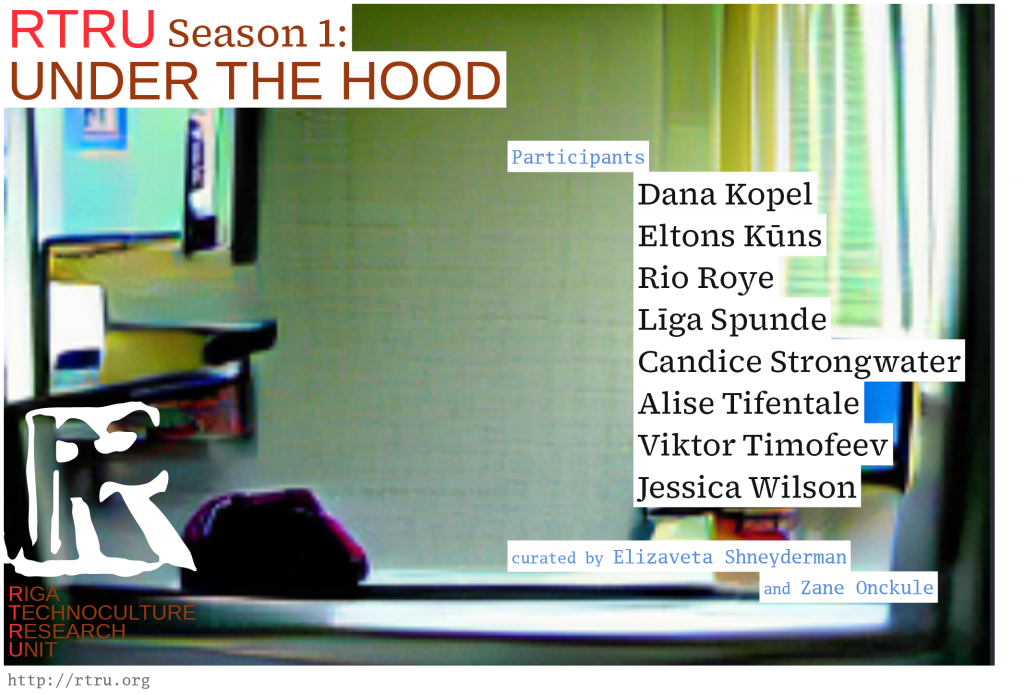Kim? Contemporary Art Centre is pleased to announce its program in February as part of the Riga Technoculture Research Unit (RTRU), co-curated with Elizaveta Shneyderman, with activities spanning online, New York and Riga.
The project is conceived in collaboration with Temnikova & Kasela Gallery (Tallinn), Rupert (Vilnius), Artnews.lt and Echogonewrong.com (Vilnius) and generously supported by Baltic Culture Fund.
Online: RTRU Season 1 launch
Under The Hood
https://www.rtru.org
RTRU Season 1 contributors/participants: Dana Kopel (New York), Eltons Kūns (Riga), Rio Roye (New York), Līga Spunde (Riga), Candice Strongwater (New York), Alise Tifentale (New York/Riga), Viktor Timofeev (New York), and Jessica Wilson (New York).
Part research journal, part art and writing publisher, part hub for developments in emerging media, RTRU brings an interdisciplinary and technicity-centered approach to the status quo of contemporary art programming. Season one, Under The Hood, looks at the technical processes and economic and social structures of production that profoundly shape visual culture. Our first season considers the museum without images; the effusive “student body”; labor history; “the factory of phenomena,” the paradigmatic worksite of contemporary media culture; and much more.
In order to understand how imaging strategies produce the aesthetic effects that we frequently and unconsciously observe in the world, we must first understand the infrastructure for how these images are made, or go “under the hood.” The way visual culture comes to be constructed is at the center of these investigations: the real-time simulations and the skeletal rigs that form the underwire of thrashing corpses, the labor laws which structure capitalist workflows, the technologically dependent student body, the visible signature of video art tropes and their affective contours, many of which have become increasingly prevalent. All of these examples belie their beginning as metrics, inputs, algorithms, and other coding languages assigned by animators, programmers, and policymakers. The images produced by these original technical apparatuses thus introduce a new level of estrangement wherein the major referent is no longer the physical world, but the technical culture behind the curtain.
KAJE, New York
Ignas Krunglevicius
Spawn
Site-specific audio installation as part of exhibition Just About in the Round, curated by Elizaveta Shneyderman (US).
Opening Reception: Friday, February 3, 2023: 6-9PM
Link to event:
https://kaje.world/upcoming
Weekend Listening Sessions:
Saturday and Sunday, February 4th & 5th: 2-5PM
Saturday and Sunday, February 11th & 12th: 2-5PM
On view till February 12th
Do you remember Twin Peaks, season 3, episode 8, when the Trinity nuclear test was depicted? After the camera zoomed into the mushroom cloud, the audience was finally introduced to the origin of Bob, where the antihero of the whole Twin Peaks saga was unleashed from the fires of the bomb. I like this little TV moment to function as a MacGuffin for us, a narrative onto which we can attach what will happen sonically at KAJE through “Spawn”.
We often recognize patterns in seemingly chaotic or nonsensical events, moments when we find meaning in the noise: Do you see faces in the clouds? This is an illusion, an apophenia – a brain glitch inherited from ancient times. But at the same time, I get a feeling that maybe there is something behind the mess. A kind of secret math. A god, or a possessive entity like Bob.
Tactile sonic rage is a prime component of the site specific installation that will take over the entirety of KAJE. Here I’ll be chasing the feeling of the ephemeral, that which happens right at the moment, in the space where the bodily senses are overloaded. Right when one can almost touch it.
– Ignas Krunglevičius
Ignas Krunglevičius (b. Kaunas, Lithuania) currently lives and works in Oslo. He received his MA in music composition from Norwegian Academy of Music in 2010. His installations, videos, and sculpture often combine sound, and text, where he explores the intermix between the agency of power, economy, nature and existential realities generated by global technological development. Krunglevičius’ works have been exhibited at the Astrup Fearnley Museum, Oslo, Norway; OCT Contemporary Art Terminal, Shanghai, China; Kunsthall Oslo, Norway; Ultima, Oslo, Norway; Institute of Contemporary Art, Philadelphia, USA; Transmediale, HKW, Berlin, Germany; La Biennale di Venezia, Nordic pavilion, Italy and The 19th Sydney Biennial, Australia, amongst others.
SAVE THE DATE
Kim? Contemporary Art Centre, Riga
Group exhibition Betweenness: Technoculture and the Baltics
24.02 – 8.04.2023
Opening: February 24th 6-9PM
Participiants: Becca Abbe (US), Uģis Albiņš (LV), Valdis Celms (LV), Jānis Dzirnieks (LV/NL), Flo Kasearu (EE), Oliver Laric (AT/DE), Deimantas Narkevičius (LT), Norman Orro & Joonas Timmi (EE), Adriana Ramić (US), TARWUK (US), Evita Vasiļjeva (LV/NL).
Curated by: Riga Technoculture Research Centre (RTRU) (Zane Onckule (LV) and Elizaveta Shneyderman (US))
Betweenness: Technoculture and the Baltics is organized as the culminating event of RTRU’s first season, which began with an inaugural exhibition and performance in New York and is followed by the launch of the online platform and magazine, rtru.org. At the heart of the exhibition is an interdisciplinary and technicity-centered approach to contemporary art programming. The term “technoculture” refers to the interactions between, and the politics of, technology and culture. It is only through active mediation and study that it is possible to effectively observe the stakes, limits, and unexamined qualities of “technoculture” within contemporary visual culture, which not only complements, but also largely develops the prerequisites to today’s reality. Bringing together intergenerational artists, scholars, researchers, programmers, and designers and researchers from the Baltics, United States, and Europe, Betweenness: Technoculture and the Baltics traces the effects that technoculture has had on artistic production over the past fifty years.
